Financial Resource Management: Budgeting, Statements, and Analysis
VerifiedAdded on 2023/06/15
|15
|2986
|223
Report
AI Summary
This report provides a comprehensive analysis of financial resource management, covering key areas such as cash budgeting, financial statement preparation, and ratio analysis. It includes a detailed cash budget for a four-month period, comments on bank balance management strategies, and an analysis of trade receivable and payable days. The report also discusses share premium and its appearance in financial statements. Furthermore, it examines profit calculations for ordinary and preference shareholders under different financing options and calculates profit per share. The analysis extends to a comparative study of financial ratios for two companies, Bopp Plc and Bill Plc, providing insights into their financial performance. Desklib offers this and many other solved assignments for students.

MANAGING FINANCIAL
RESOURCES
RESOURCES
Paraphrase This Document
Need a fresh take? Get an instant paraphrase of this document with our AI Paraphraser
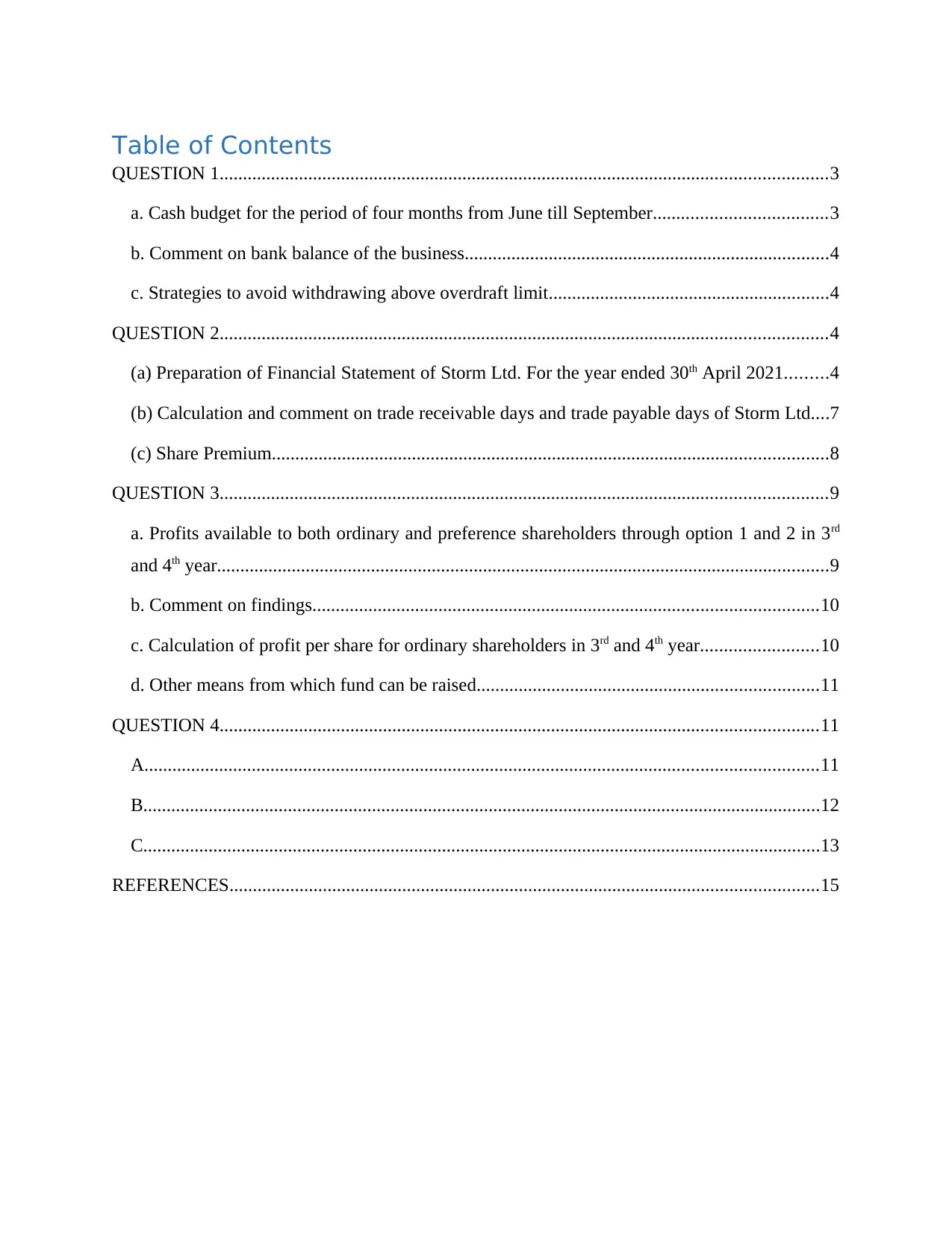
Table of Contents
QUESTION 1..................................................................................................................................3
a. Cash budget for the period of four months from June till September.....................................3
b. Comment on bank balance of the business..............................................................................4
c. Strategies to avoid withdrawing above overdraft limit............................................................4
QUESTION 2..................................................................................................................................4
(a) Preparation of Financial Statement of Storm Ltd. For the year ended 30th April 2021.........4
(b) Calculation and comment on trade receivable days and trade payable days of Storm Ltd....7
(c) Share Premium.......................................................................................................................8
QUESTION 3..................................................................................................................................9
a. Profits available to both ordinary and preference shareholders through option 1 and 2 in 3rd
and 4th year...................................................................................................................................9
b. Comment on findings............................................................................................................10
c. Calculation of profit per share for ordinary shareholders in 3rd and 4th year.........................10
d. Other means from which fund can be raised.........................................................................11
QUESTION 4................................................................................................................................11
A................................................................................................................................................11
B.................................................................................................................................................12
C.................................................................................................................................................13
REFERENCES..............................................................................................................................15
QUESTION 1..................................................................................................................................3
a. Cash budget for the period of four months from June till September.....................................3
b. Comment on bank balance of the business..............................................................................4
c. Strategies to avoid withdrawing above overdraft limit............................................................4
QUESTION 2..................................................................................................................................4
(a) Preparation of Financial Statement of Storm Ltd. For the year ended 30th April 2021.........4
(b) Calculation and comment on trade receivable days and trade payable days of Storm Ltd....7
(c) Share Premium.......................................................................................................................8
QUESTION 3..................................................................................................................................9
a. Profits available to both ordinary and preference shareholders through option 1 and 2 in 3rd
and 4th year...................................................................................................................................9
b. Comment on findings............................................................................................................10
c. Calculation of profit per share for ordinary shareholders in 3rd and 4th year.........................10
d. Other means from which fund can be raised.........................................................................11
QUESTION 4................................................................................................................................11
A................................................................................................................................................11
B.................................................................................................................................................12
C.................................................................................................................................................13
REFERENCES..............................................................................................................................15
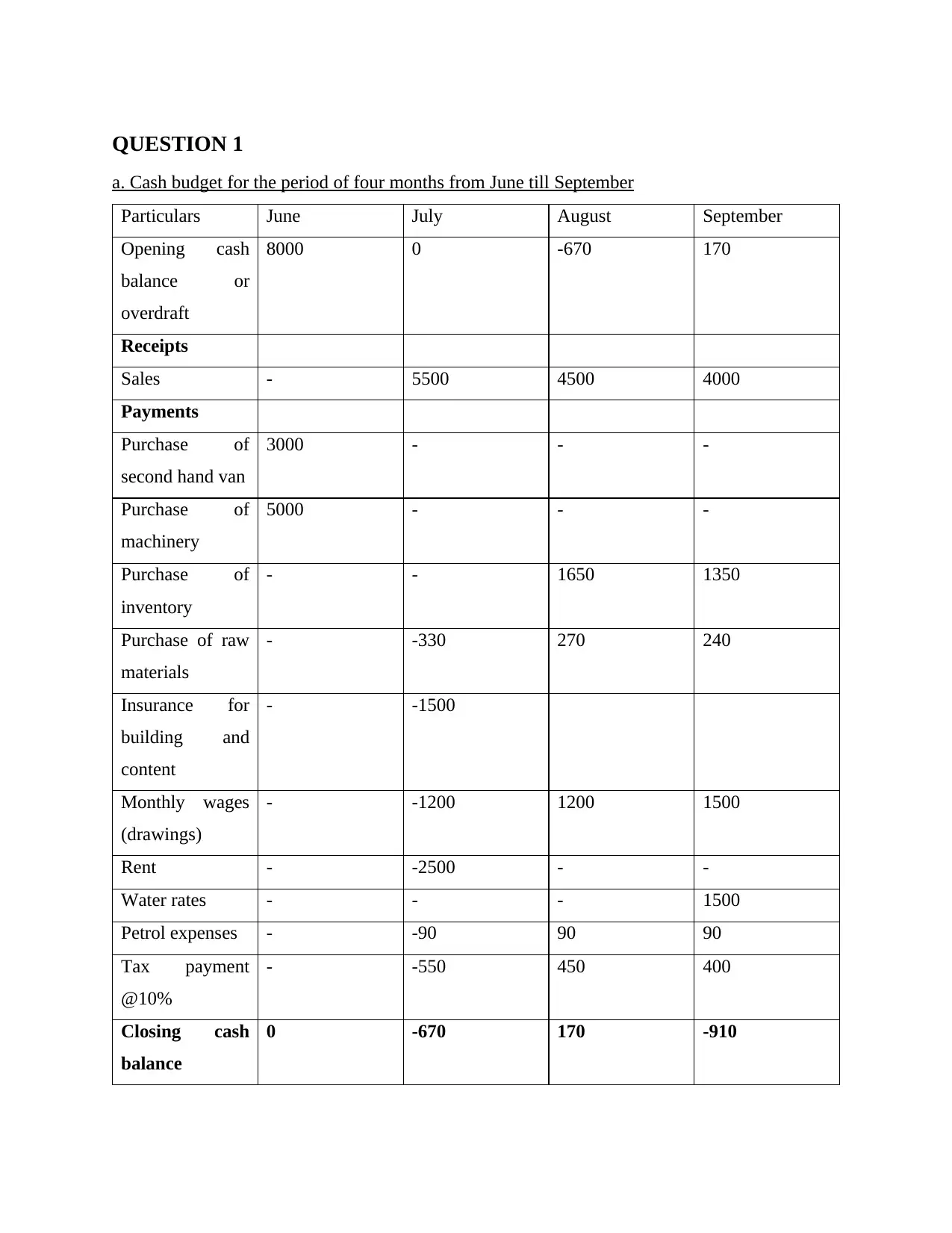
QUESTION 1
a. Cash budget for the period of four months from June till September
Particulars June July August September
Opening cash
balance or
overdraft
8000 0 -670 170
Receipts
Sales - 5500 4500 4000
Payments
Purchase of
second hand van
3000 - - -
Purchase of
machinery
5000 - - -
Purchase of
inventory
- - 1650 1350
Purchase of raw
materials
- -330 270 240
Insurance for
building and
content
- -1500
Monthly wages
(drawings)
- -1200 1200 1500
Rent - -2500 - -
Water rates - - - 1500
Petrol expenses - -90 90 90
Tax payment
@10%
- -550 450 400
Closing cash
balance
0 -670 170 -910
a. Cash budget for the period of four months from June till September
Particulars June July August September
Opening cash
balance or
overdraft
8000 0 -670 170
Receipts
Sales - 5500 4500 4000
Payments
Purchase of
second hand van
3000 - - -
Purchase of
machinery
5000 - - -
Purchase of
inventory
- - 1650 1350
Purchase of raw
materials
- -330 270 240
Insurance for
building and
content
- -1500
Monthly wages
(drawings)
- -1200 1200 1500
Rent - -2500 - -
Water rates - - - 1500
Petrol expenses - -90 90 90
Tax payment
@10%
- -550 450 400
Closing cash
balance
0 -670 170 -910
⊘ This is a preview!⊘
Do you want full access?
Subscribe today to unlock all pages.

Trusted by 1+ million students worldwide
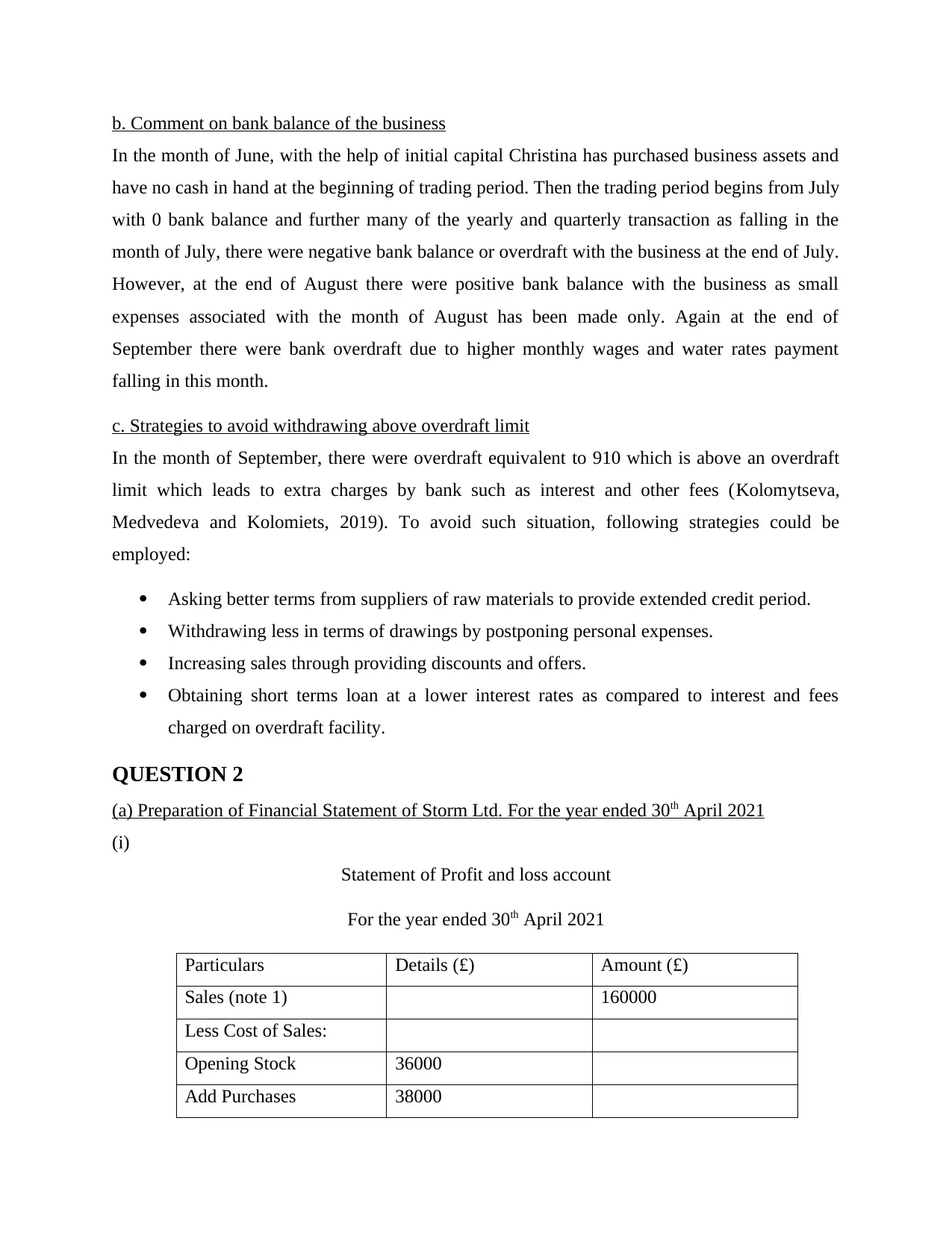
b. Comment on bank balance of the business
In the month of June, with the help of initial capital Christina has purchased business assets and
have no cash in hand at the beginning of trading period. Then the trading period begins from July
with 0 bank balance and further many of the yearly and quarterly transaction as falling in the
month of July, there were negative bank balance or overdraft with the business at the end of July.
However, at the end of August there were positive bank balance with the business as small
expenses associated with the month of August has been made only. Again at the end of
September there were bank overdraft due to higher monthly wages and water rates payment
falling in this month.
c. Strategies to avoid withdrawing above overdraft limit
In the month of September, there were overdraft equivalent to 910 which is above an overdraft
limit which leads to extra charges by bank such as interest and other fees (Kolomytseva,
Medvedeva and Kolomiets, 2019). To avoid such situation, following strategies could be
employed:
Asking better terms from suppliers of raw materials to provide extended credit period.
Withdrawing less in terms of drawings by postponing personal expenses.
Increasing sales through providing discounts and offers.
Obtaining short terms loan at a lower interest rates as compared to interest and fees
charged on overdraft facility.
QUESTION 2
(a) Preparation of Financial Statement of Storm Ltd. For the year ended 30th April 2021
(i)
Statement of Profit and loss account
For the year ended 30th April 2021
Particulars Details (£) Amount (£)
Sales (note 1) 160000
Less Cost of Sales:
Opening Stock 36000
Add Purchases 38000
In the month of June, with the help of initial capital Christina has purchased business assets and
have no cash in hand at the beginning of trading period. Then the trading period begins from July
with 0 bank balance and further many of the yearly and quarterly transaction as falling in the
month of July, there were negative bank balance or overdraft with the business at the end of July.
However, at the end of August there were positive bank balance with the business as small
expenses associated with the month of August has been made only. Again at the end of
September there were bank overdraft due to higher monthly wages and water rates payment
falling in this month.
c. Strategies to avoid withdrawing above overdraft limit
In the month of September, there were overdraft equivalent to 910 which is above an overdraft
limit which leads to extra charges by bank such as interest and other fees (Kolomytseva,
Medvedeva and Kolomiets, 2019). To avoid such situation, following strategies could be
employed:
Asking better terms from suppliers of raw materials to provide extended credit period.
Withdrawing less in terms of drawings by postponing personal expenses.
Increasing sales through providing discounts and offers.
Obtaining short terms loan at a lower interest rates as compared to interest and fees
charged on overdraft facility.
QUESTION 2
(a) Preparation of Financial Statement of Storm Ltd. For the year ended 30th April 2021
(i)
Statement of Profit and loss account
For the year ended 30th April 2021
Particulars Details (£) Amount (£)
Sales (note 1) 160000
Less Cost of Sales:
Opening Stock 36000
Add Purchases 38000
Paraphrase This Document
Need a fresh take? Get an instant paraphrase of this document with our AI Paraphraser
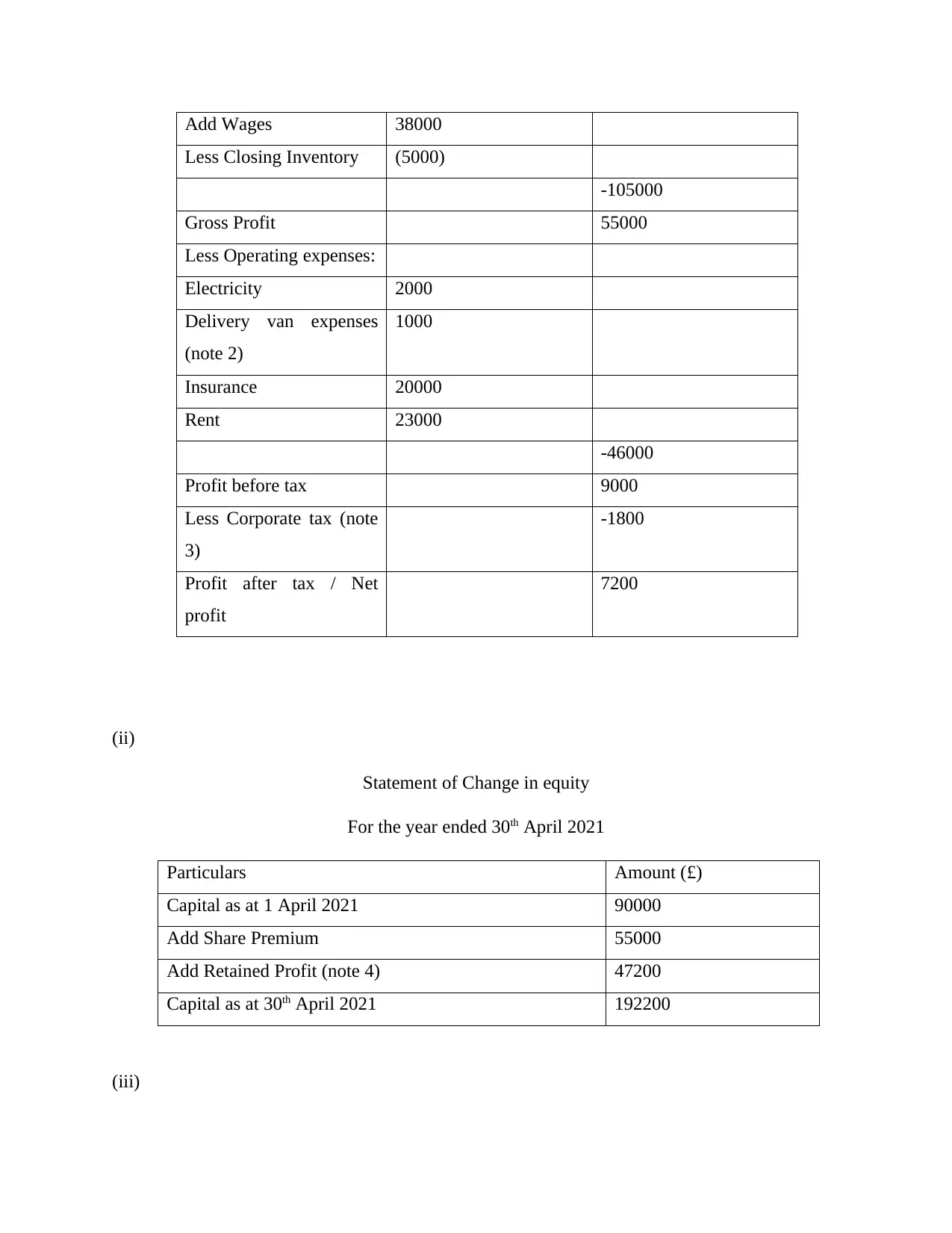
Add Wages 38000
Less Closing Inventory (5000)
-105000
Gross Profit 55000
Less Operating expenses:
Electricity 2000
Delivery van expenses
(note 2)
1000
Insurance 20000
Rent 23000
-46000
Profit before tax 9000
Less Corporate tax (note
3)
-1800
Profit after tax / Net
profit
7200
(ii)
Statement of Change in equity
For the year ended 30th April 2021
Particulars Amount (£)
Capital as at 1 April 2021 90000
Add Share Premium 55000
Add Retained Profit (note 4) 47200
Capital as at 30th April 2021 192200
(iii)
Less Closing Inventory (5000)
-105000
Gross Profit 55000
Less Operating expenses:
Electricity 2000
Delivery van expenses
(note 2)
1000
Insurance 20000
Rent 23000
-46000
Profit before tax 9000
Less Corporate tax (note
3)
-1800
Profit after tax / Net
profit
7200
(ii)
Statement of Change in equity
For the year ended 30th April 2021
Particulars Amount (£)
Capital as at 1 April 2021 90000
Add Share Premium 55000
Add Retained Profit (note 4) 47200
Capital as at 30th April 2021 192200
(iii)
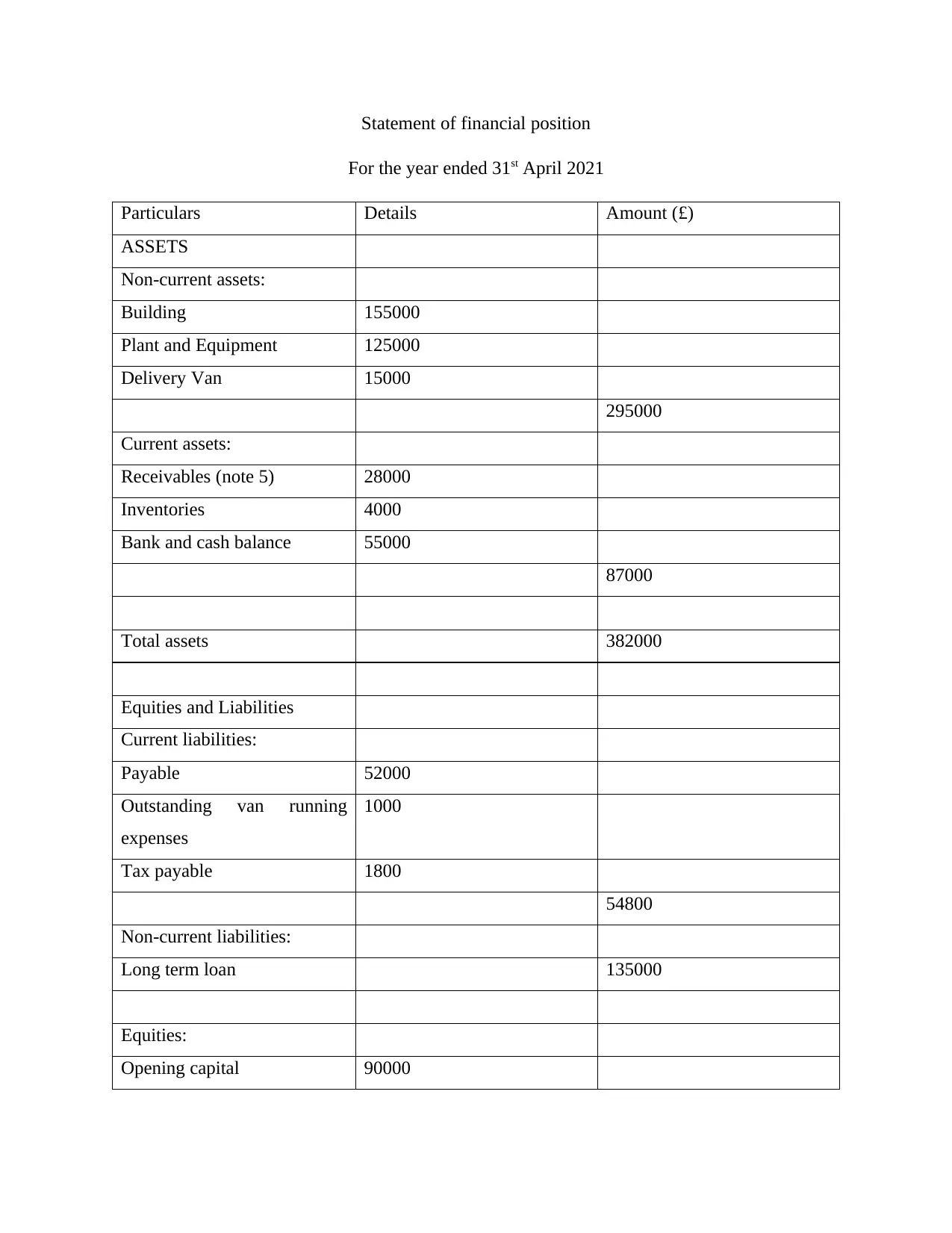
Statement of financial position
For the year ended 31st April 2021
Particulars Details Amount (£)
ASSETS
Non-current assets:
Building 155000
Plant and Equipment 125000
Delivery Van 15000
295000
Current assets:
Receivables (note 5) 28000
Inventories 4000
Bank and cash balance 55000
87000
Total assets 382000
Equities and Liabilities
Current liabilities:
Payable 52000
Outstanding van running
expenses
1000
Tax payable 1800
54800
Non-current liabilities:
Long term loan 135000
Equities:
Opening capital 90000
For the year ended 31st April 2021
Particulars Details Amount (£)
ASSETS
Non-current assets:
Building 155000
Plant and Equipment 125000
Delivery Van 15000
295000
Current assets:
Receivables (note 5) 28000
Inventories 4000
Bank and cash balance 55000
87000
Total assets 382000
Equities and Liabilities
Current liabilities:
Payable 52000
Outstanding van running
expenses
1000
Tax payable 1800
54800
Non-current liabilities:
Long term loan 135000
Equities:
Opening capital 90000
⊘ This is a preview!⊘
Do you want full access?
Subscribe today to unlock all pages.

Trusted by 1+ million students worldwide
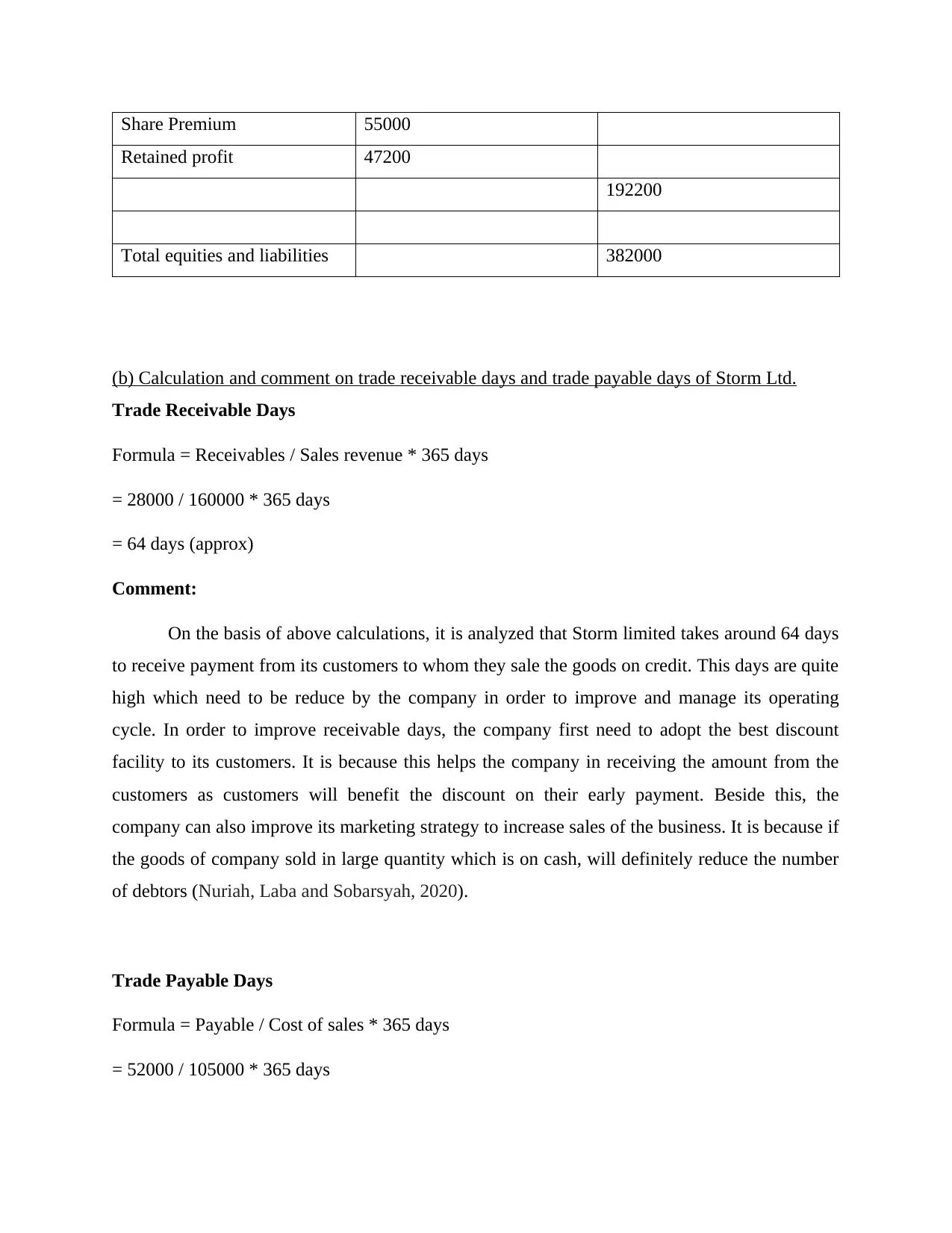
Share Premium 55000
Retained profit 47200
192200
Total equities and liabilities 382000
(b) Calculation and comment on trade receivable days and trade payable days of Storm Ltd.
Trade Receivable Days
Formula = Receivables / Sales revenue * 365 days
= 28000 / 160000 * 365 days
= 64 days (approx)
Comment:
On the basis of above calculations, it is analyzed that Storm limited takes around 64 days
to receive payment from its customers to whom they sale the goods on credit. This days are quite
high which need to be reduce by the company in order to improve and manage its operating
cycle. In order to improve receivable days, the company first need to adopt the best discount
facility to its customers. It is because this helps the company in receiving the amount from the
customers as customers will benefit the discount on their early payment. Beside this, the
company can also improve its marketing strategy to increase sales of the business. It is because if
the goods of company sold in large quantity which is on cash, will definitely reduce the number
of debtors (Nuriah, Laba and Sobarsyah, 2020).
Trade Payable Days
Formula = Payable / Cost of sales * 365 days
= 52000 / 105000 * 365 days
Retained profit 47200
192200
Total equities and liabilities 382000
(b) Calculation and comment on trade receivable days and trade payable days of Storm Ltd.
Trade Receivable Days
Formula = Receivables / Sales revenue * 365 days
= 28000 / 160000 * 365 days
= 64 days (approx)
Comment:
On the basis of above calculations, it is analyzed that Storm limited takes around 64 days
to receive payment from its customers to whom they sale the goods on credit. This days are quite
high which need to be reduce by the company in order to improve and manage its operating
cycle. In order to improve receivable days, the company first need to adopt the best discount
facility to its customers. It is because this helps the company in receiving the amount from the
customers as customers will benefit the discount on their early payment. Beside this, the
company can also improve its marketing strategy to increase sales of the business. It is because if
the goods of company sold in large quantity which is on cash, will definitely reduce the number
of debtors (Nuriah, Laba and Sobarsyah, 2020).
Trade Payable Days
Formula = Payable / Cost of sales * 365 days
= 52000 / 105000 * 365 days
Paraphrase This Document
Need a fresh take? Get an instant paraphrase of this document with our AI Paraphraser
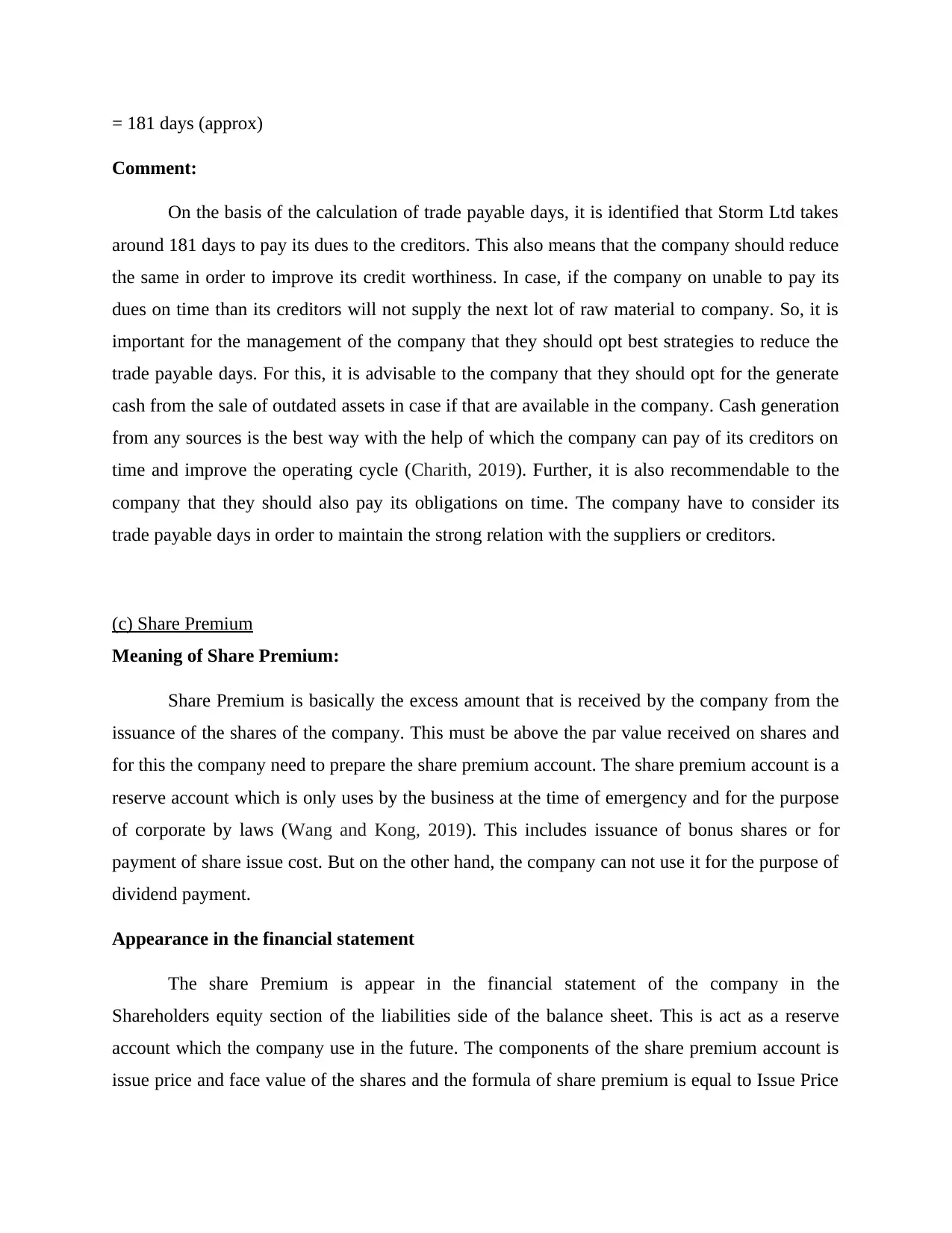
= 181 days (approx)
Comment:
On the basis of the calculation of trade payable days, it is identified that Storm Ltd takes
around 181 days to pay its dues to the creditors. This also means that the company should reduce
the same in order to improve its credit worthiness. In case, if the company on unable to pay its
dues on time than its creditors will not supply the next lot of raw material to company. So, it is
important for the management of the company that they should opt best strategies to reduce the
trade payable days. For this, it is advisable to the company that they should opt for the generate
cash from the sale of outdated assets in case if that are available in the company. Cash generation
from any sources is the best way with the help of which the company can pay of its creditors on
time and improve the operating cycle (Charith, 2019). Further, it is also recommendable to the
company that they should also pay its obligations on time. The company have to consider its
trade payable days in order to maintain the strong relation with the suppliers or creditors.
(c) Share Premium
Meaning of Share Premium:
Share Premium is basically the excess amount that is received by the company from the
issuance of the shares of the company. This must be above the par value received on shares and
for this the company need to prepare the share premium account. The share premium account is a
reserve account which is only uses by the business at the time of emergency and for the purpose
of corporate by laws (Wang and Kong, 2019). This includes issuance of bonus shares or for
payment of share issue cost. But on the other hand, the company can not use it for the purpose of
dividend payment.
Appearance in the financial statement
The share Premium is appear in the financial statement of the company in the
Shareholders equity section of the liabilities side of the balance sheet. This is act as a reserve
account which the company use in the future. The components of the share premium account is
issue price and face value of the shares and the formula of share premium is equal to Issue Price
Comment:
On the basis of the calculation of trade payable days, it is identified that Storm Ltd takes
around 181 days to pay its dues to the creditors. This also means that the company should reduce
the same in order to improve its credit worthiness. In case, if the company on unable to pay its
dues on time than its creditors will not supply the next lot of raw material to company. So, it is
important for the management of the company that they should opt best strategies to reduce the
trade payable days. For this, it is advisable to the company that they should opt for the generate
cash from the sale of outdated assets in case if that are available in the company. Cash generation
from any sources is the best way with the help of which the company can pay of its creditors on
time and improve the operating cycle (Charith, 2019). Further, it is also recommendable to the
company that they should also pay its obligations on time. The company have to consider its
trade payable days in order to maintain the strong relation with the suppliers or creditors.
(c) Share Premium
Meaning of Share Premium:
Share Premium is basically the excess amount that is received by the company from the
issuance of the shares of the company. This must be above the par value received on shares and
for this the company need to prepare the share premium account. The share premium account is a
reserve account which is only uses by the business at the time of emergency and for the purpose
of corporate by laws (Wang and Kong, 2019). This includes issuance of bonus shares or for
payment of share issue cost. But on the other hand, the company can not use it for the purpose of
dividend payment.
Appearance in the financial statement
The share Premium is appear in the financial statement of the company in the
Shareholders equity section of the liabilities side of the balance sheet. This is act as a reserve
account which the company use in the future. The components of the share premium account is
issue price and face value of the shares and the formula of share premium is equal to Issue Price
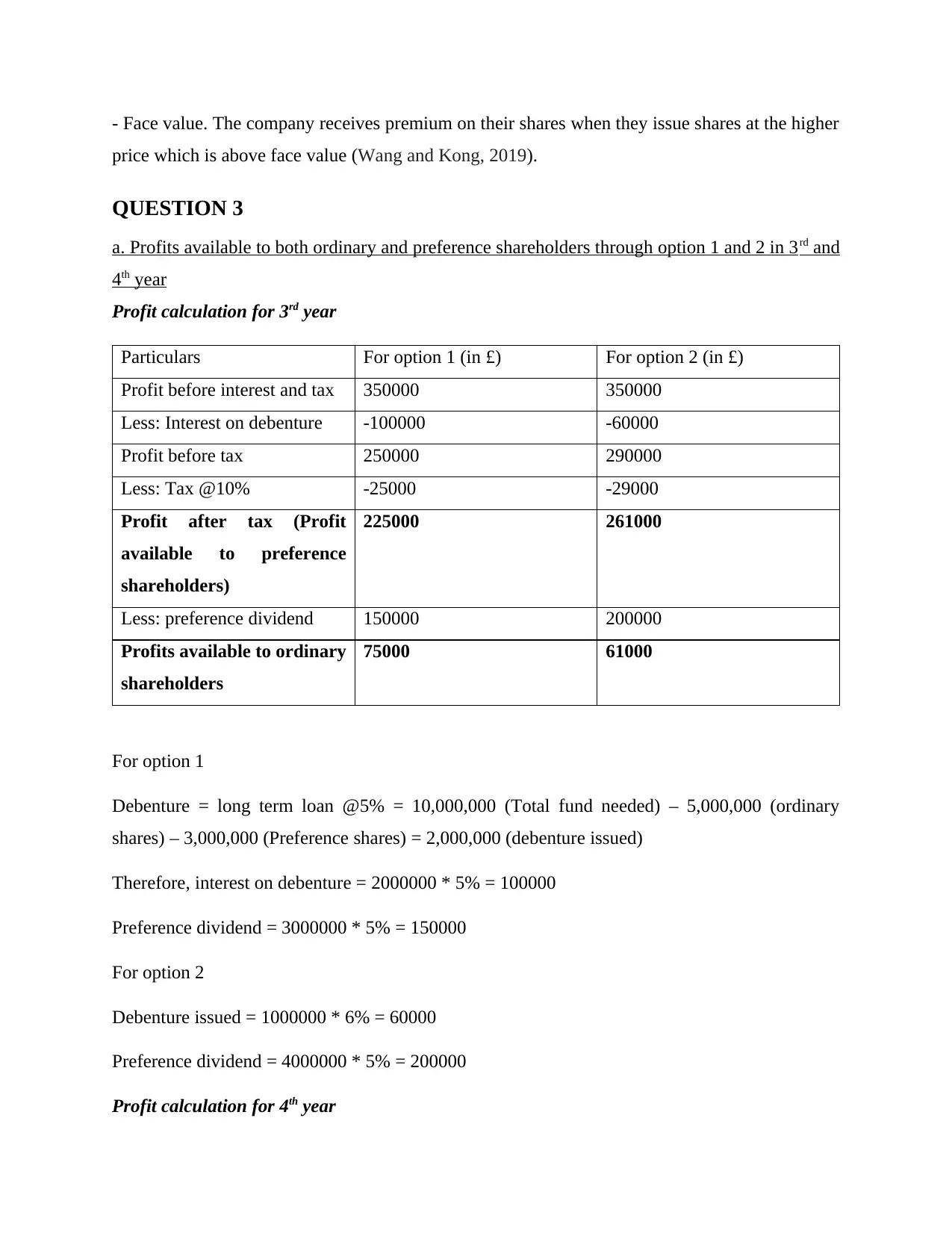
- Face value. The company receives premium on their shares when they issue shares at the higher
price which is above face value (Wang and Kong, 2019).
QUESTION 3
a. Profits available to both ordinary and preference shareholders through option 1 and 2 in 3rd and
4th year
Profit calculation for 3rd year
Particulars For option 1 (in £) For option 2 (in £)
Profit before interest and tax 350000 350000
Less: Interest on debenture -100000 -60000
Profit before tax 250000 290000
Less: Tax @10% -25000 -29000
Profit after tax (Profit
available to preference
shareholders)
225000 261000
Less: preference dividend 150000 200000
Profits available to ordinary
shareholders
75000 61000
For option 1
Debenture = long term loan @5% = 10,000,000 (Total fund needed) – 5,000,000 (ordinary
shares) – 3,000,000 (Preference shares) = 2,000,000 (debenture issued)
Therefore, interest on debenture = 2000000 * 5% = 100000
Preference dividend = 3000000 * 5% = 150000
For option 2
Debenture issued = 1000000 * 6% = 60000
Preference dividend = 4000000 * 5% = 200000
Profit calculation for 4th year
price which is above face value (Wang and Kong, 2019).
QUESTION 3
a. Profits available to both ordinary and preference shareholders through option 1 and 2 in 3rd and
4th year
Profit calculation for 3rd year
Particulars For option 1 (in £) For option 2 (in £)
Profit before interest and tax 350000 350000
Less: Interest on debenture -100000 -60000
Profit before tax 250000 290000
Less: Tax @10% -25000 -29000
Profit after tax (Profit
available to preference
shareholders)
225000 261000
Less: preference dividend 150000 200000
Profits available to ordinary
shareholders
75000 61000
For option 1
Debenture = long term loan @5% = 10,000,000 (Total fund needed) – 5,000,000 (ordinary
shares) – 3,000,000 (Preference shares) = 2,000,000 (debenture issued)
Therefore, interest on debenture = 2000000 * 5% = 100000
Preference dividend = 3000000 * 5% = 150000
For option 2
Debenture issued = 1000000 * 6% = 60000
Preference dividend = 4000000 * 5% = 200000
Profit calculation for 4th year
⊘ This is a preview!⊘
Do you want full access?
Subscribe today to unlock all pages.

Trusted by 1+ million students worldwide
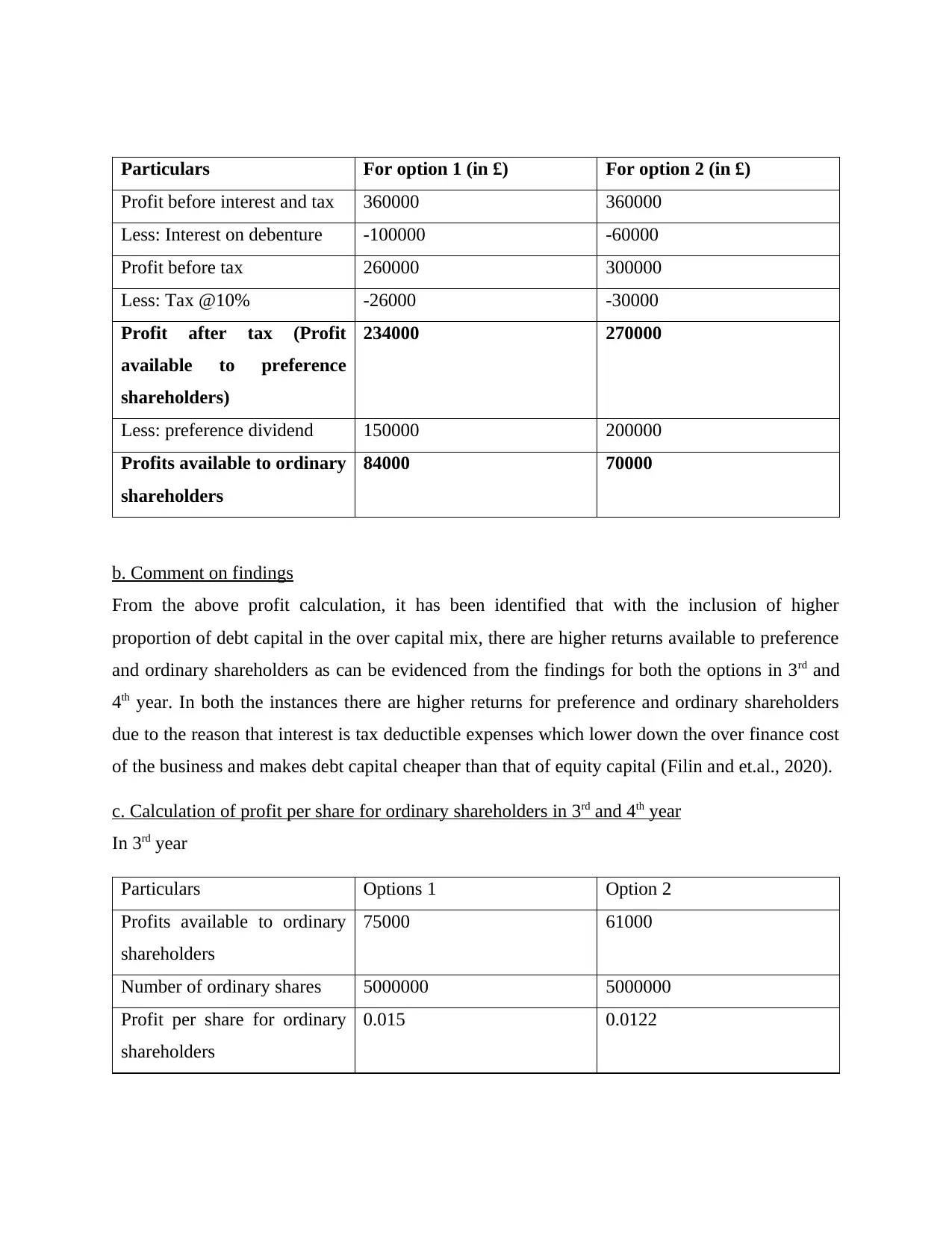
Particulars For option 1 (in £) For option 2 (in £)
Profit before interest and tax 360000 360000
Less: Interest on debenture -100000 -60000
Profit before tax 260000 300000
Less: Tax @10% -26000 -30000
Profit after tax (Profit
available to preference
shareholders)
234000 270000
Less: preference dividend 150000 200000
Profits available to ordinary
shareholders
84000 70000
b. Comment on findings
From the above profit calculation, it has been identified that with the inclusion of higher
proportion of debt capital in the over capital mix, there are higher returns available to preference
and ordinary shareholders as can be evidenced from the findings for both the options in 3rd and
4th year. In both the instances there are higher returns for preference and ordinary shareholders
due to the reason that interest is tax deductible expenses which lower down the over finance cost
of the business and makes debt capital cheaper than that of equity capital (Filin and et.al., 2020).
c. Calculation of profit per share for ordinary shareholders in 3rd and 4th year
In 3rd year
Particulars Options 1 Option 2
Profits available to ordinary
shareholders
75000 61000
Number of ordinary shares 5000000 5000000
Profit per share for ordinary
shareholders
0.015 0.0122
Profit before interest and tax 360000 360000
Less: Interest on debenture -100000 -60000
Profit before tax 260000 300000
Less: Tax @10% -26000 -30000
Profit after tax (Profit
available to preference
shareholders)
234000 270000
Less: preference dividend 150000 200000
Profits available to ordinary
shareholders
84000 70000
b. Comment on findings
From the above profit calculation, it has been identified that with the inclusion of higher
proportion of debt capital in the over capital mix, there are higher returns available to preference
and ordinary shareholders as can be evidenced from the findings for both the options in 3rd and
4th year. In both the instances there are higher returns for preference and ordinary shareholders
due to the reason that interest is tax deductible expenses which lower down the over finance cost
of the business and makes debt capital cheaper than that of equity capital (Filin and et.al., 2020).
c. Calculation of profit per share for ordinary shareholders in 3rd and 4th year
In 3rd year
Particulars Options 1 Option 2
Profits available to ordinary
shareholders
75000 61000
Number of ordinary shares 5000000 5000000
Profit per share for ordinary
shareholders
0.015 0.0122
Paraphrase This Document
Need a fresh take? Get an instant paraphrase of this document with our AI Paraphraser

In 4th year
Particulars Options 1 Option 2
Profits available to ordinary
shareholders
84000 70000
Number of ordinary shares 5000000 5000000
Profit per share for ordinary
shareholders
0.0168 0.014
d. Other means from which fund can be raised
Other than equity and debt instruments as mentioned above, there is another most important
sources from which the company can finance its business expansion is retained earnings
(Merianos and Gotsis, 2018). It is the fund that is available through company reserves which
they maintained for the surpluses left after distributing dividend to ordinary shareholders. The
funding available through this sources is the cheapest of all other sources as company need not
require to bear the cost of raising fund through external sources.
QUESTION 4
A
Particular Formula
Bopp
Plc
Bill
Plc
Trade receivable ratio
Average account receivable/ annual total
sales*365 44 66
Average account
receivable 176.4 321.9
Sales 1478.1 1790.4
Particular Formula Bopp Plc Bill Plc
Current ratio Current asset/ current liabilities 2.02 2.79
Particulars Options 1 Option 2
Profits available to ordinary
shareholders
84000 70000
Number of ordinary shares 5000000 5000000
Profit per share for ordinary
shareholders
0.0168 0.014
d. Other means from which fund can be raised
Other than equity and debt instruments as mentioned above, there is another most important
sources from which the company can finance its business expansion is retained earnings
(Merianos and Gotsis, 2018). It is the fund that is available through company reserves which
they maintained for the surpluses left after distributing dividend to ordinary shareholders. The
funding available through this sources is the cheapest of all other sources as company need not
require to bear the cost of raising fund through external sources.
QUESTION 4
A
Particular Formula
Bopp
Plc
Bill
Plc
Trade receivable ratio
Average account receivable/ annual total
sales*365 44 66
Average account
receivable 176.4 321.9
Sales 1478.1 1790.4
Particular Formula Bopp Plc Bill Plc
Current ratio Current asset/ current liabilities 2.02 2.79
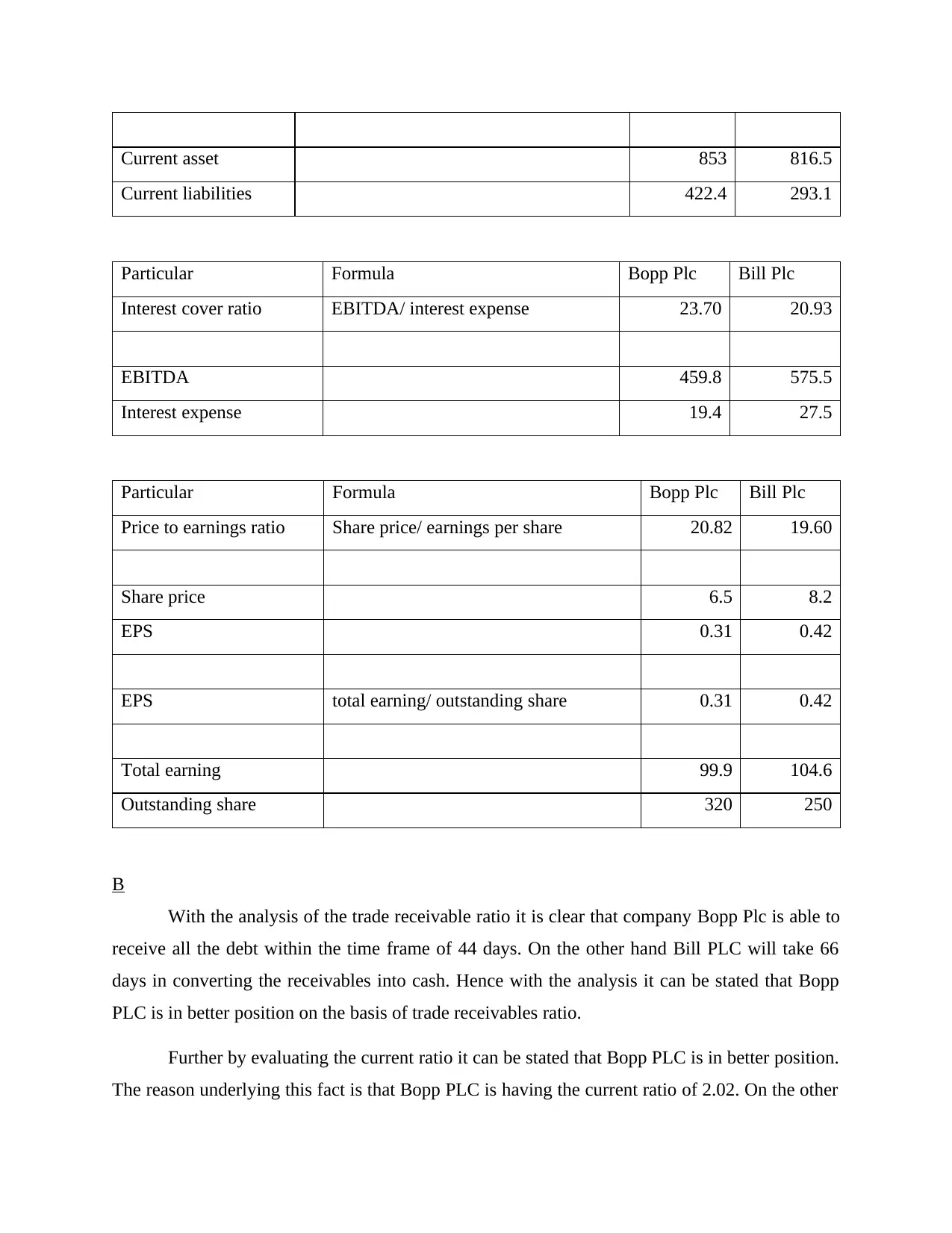
Current asset 853 816.5
Current liabilities 422.4 293.1
Particular Formula Bopp Plc Bill Plc
Interest cover ratio EBITDA/ interest expense 23.70 20.93
EBITDA 459.8 575.5
Interest expense 19.4 27.5
Particular Formula Bopp Plc Bill Plc
Price to earnings ratio Share price/ earnings per share 20.82 19.60
Share price 6.5 8.2
EPS 0.31 0.42
EPS total earning/ outstanding share 0.31 0.42
Total earning 99.9 104.6
Outstanding share 320 250
B
With the analysis of the trade receivable ratio it is clear that company Bopp Plc is able to
receive all the debt within the time frame of 44 days. On the other hand Bill PLC will take 66
days in converting the receivables into cash. Hence with the analysis it can be stated that Bopp
PLC is in better position on the basis of trade receivables ratio.
Further by evaluating the current ratio it can be stated that Bopp PLC is in better position.
The reason underlying this fact is that Bopp PLC is having the current ratio of 2.02. On the other
Current liabilities 422.4 293.1
Particular Formula Bopp Plc Bill Plc
Interest cover ratio EBITDA/ interest expense 23.70 20.93
EBITDA 459.8 575.5
Interest expense 19.4 27.5
Particular Formula Bopp Plc Bill Plc
Price to earnings ratio Share price/ earnings per share 20.82 19.60
Share price 6.5 8.2
EPS 0.31 0.42
EPS total earning/ outstanding share 0.31 0.42
Total earning 99.9 104.6
Outstanding share 320 250
B
With the analysis of the trade receivable ratio it is clear that company Bopp Plc is able to
receive all the debt within the time frame of 44 days. On the other hand Bill PLC will take 66
days in converting the receivables into cash. Hence with the analysis it can be stated that Bopp
PLC is in better position on the basis of trade receivables ratio.
Further by evaluating the current ratio it can be stated that Bopp PLC is in better position.
The reason underlying this fact is that Bopp PLC is having the current ratio of 2.02. On the other
⊘ This is a preview!⊘
Do you want full access?
Subscribe today to unlock all pages.

Trusted by 1+ million students worldwide
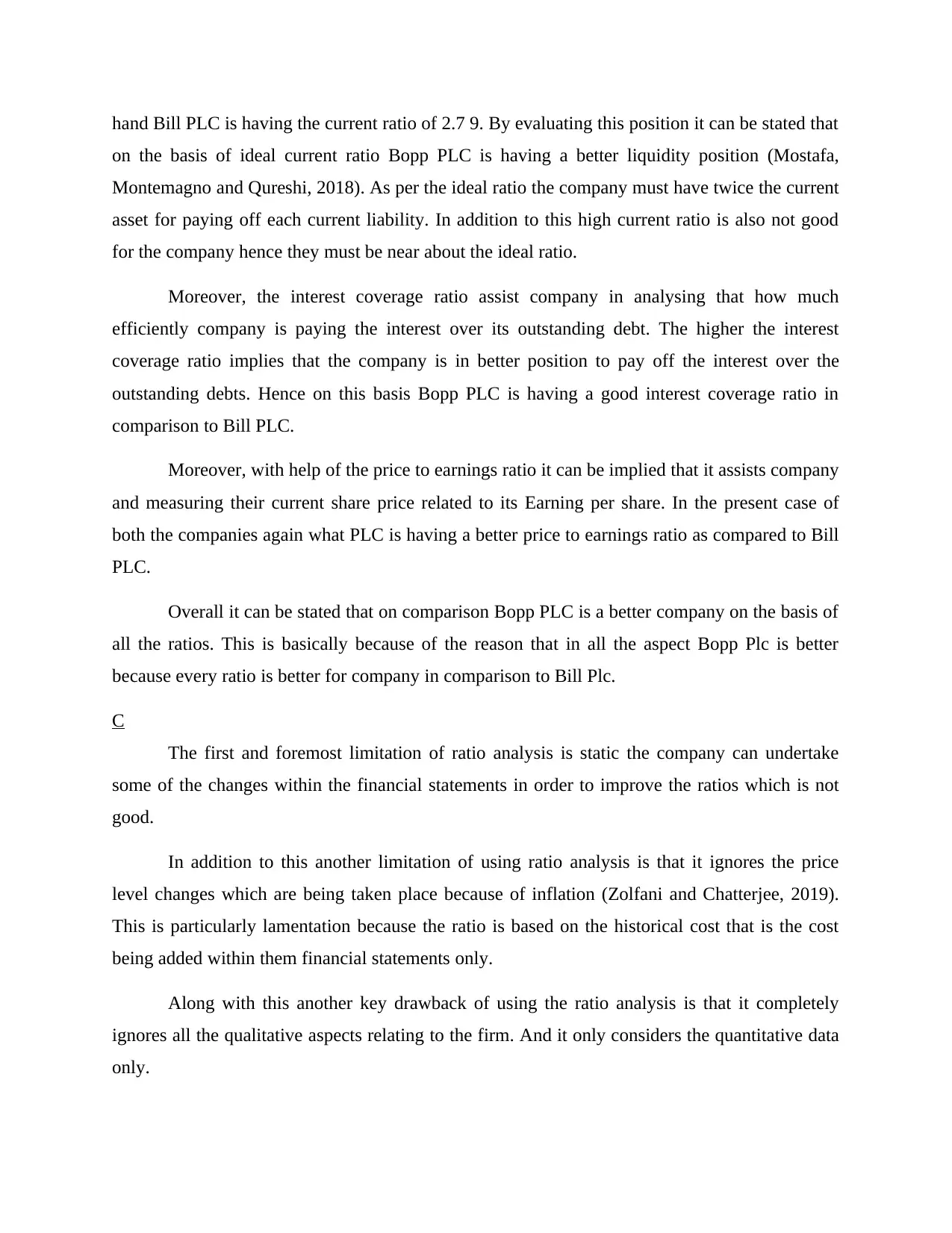
hand Bill PLC is having the current ratio of 2.7 9. By evaluating this position it can be stated that
on the basis of ideal current ratio Bopp PLC is having a better liquidity position (Mostafa,
Montemagno and Qureshi, 2018). As per the ideal ratio the company must have twice the current
asset for paying off each current liability. In addition to this high current ratio is also not good
for the company hence they must be near about the ideal ratio.
Moreover, the interest coverage ratio assist company in analysing that how much
efficiently company is paying the interest over its outstanding debt. The higher the interest
coverage ratio implies that the company is in better position to pay off the interest over the
outstanding debts. Hence on this basis Bopp PLC is having a good interest coverage ratio in
comparison to Bill PLC.
Moreover, with help of the price to earnings ratio it can be implied that it assists company
and measuring their current share price related to its Earning per share. In the present case of
both the companies again what PLC is having a better price to earnings ratio as compared to Bill
PLC.
Overall it can be stated that on comparison Bopp PLC is a better company on the basis of
all the ratios. This is basically because of the reason that in all the aspect Bopp Plc is better
because every ratio is better for company in comparison to Bill Plc.
C
The first and foremost limitation of ratio analysis is static the company can undertake
some of the changes within the financial statements in order to improve the ratios which is not
good.
In addition to this another limitation of using ratio analysis is that it ignores the price
level changes which are being taken place because of inflation (Zolfani and Chatterjee, 2019).
This is particularly lamentation because the ratio is based on the historical cost that is the cost
being added within them financial statements only.
Along with this another key drawback of using the ratio analysis is that it completely
ignores all the qualitative aspects relating to the firm. And it only considers the quantitative data
only.
on the basis of ideal current ratio Bopp PLC is having a better liquidity position (Mostafa,
Montemagno and Qureshi, 2018). As per the ideal ratio the company must have twice the current
asset for paying off each current liability. In addition to this high current ratio is also not good
for the company hence they must be near about the ideal ratio.
Moreover, the interest coverage ratio assist company in analysing that how much
efficiently company is paying the interest over its outstanding debt. The higher the interest
coverage ratio implies that the company is in better position to pay off the interest over the
outstanding debts. Hence on this basis Bopp PLC is having a good interest coverage ratio in
comparison to Bill PLC.
Moreover, with help of the price to earnings ratio it can be implied that it assists company
and measuring their current share price related to its Earning per share. In the present case of
both the companies again what PLC is having a better price to earnings ratio as compared to Bill
PLC.
Overall it can be stated that on comparison Bopp PLC is a better company on the basis of
all the ratios. This is basically because of the reason that in all the aspect Bopp Plc is better
because every ratio is better for company in comparison to Bill Plc.
C
The first and foremost limitation of ratio analysis is static the company can undertake
some of the changes within the financial statements in order to improve the ratios which is not
good.
In addition to this another limitation of using ratio analysis is that it ignores the price
level changes which are being taken place because of inflation (Zolfani and Chatterjee, 2019).
This is particularly lamentation because the ratio is based on the historical cost that is the cost
being added within them financial statements only.
Along with this another key drawback of using the ratio analysis is that it completely
ignores all the qualitative aspects relating to the firm. And it only considers the quantitative data
only.
Paraphrase This Document
Need a fresh take? Get an instant paraphrase of this document with our AI Paraphraser
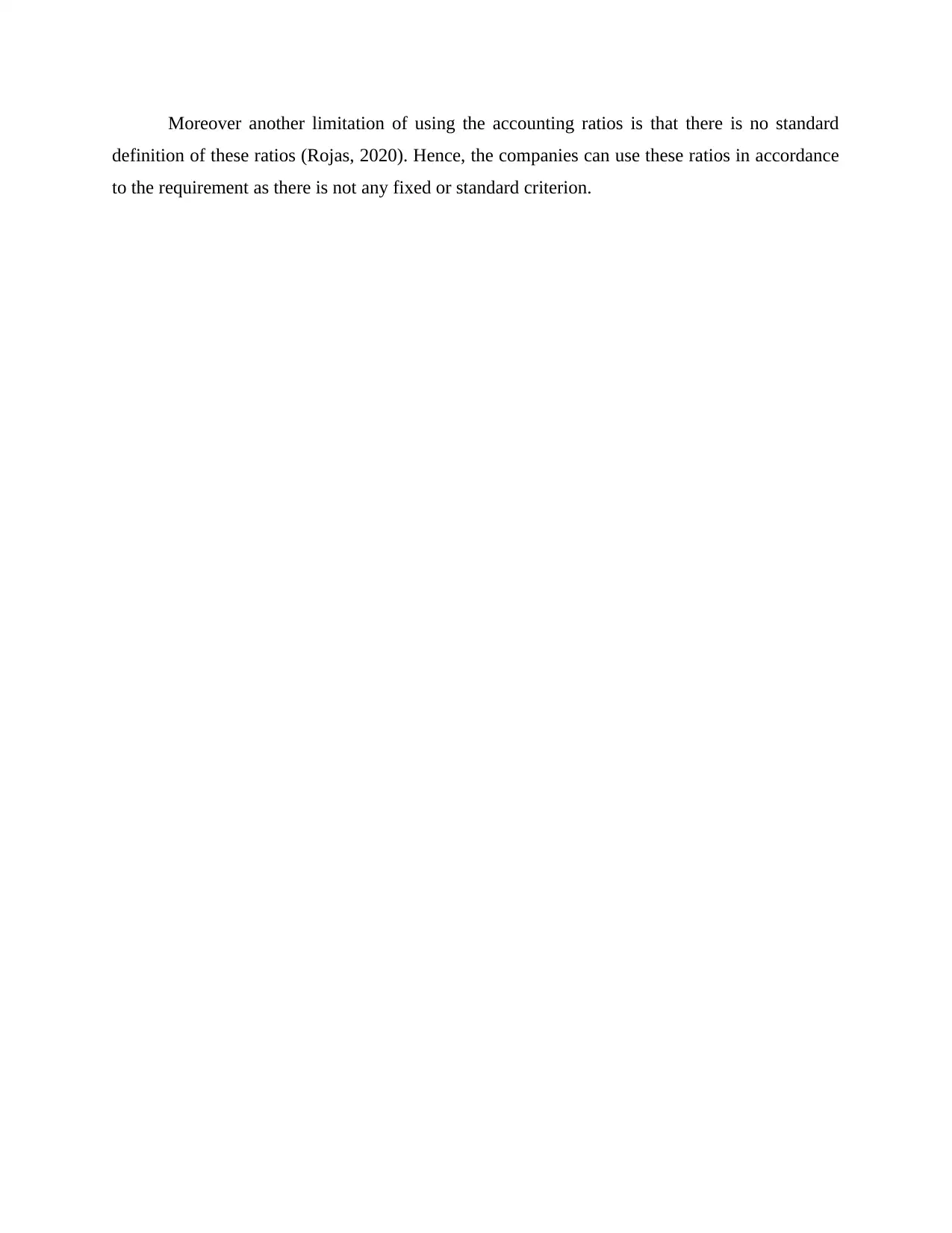
Moreover another limitation of using the accounting ratios is that there is no standard
definition of these ratios (Rojas, 2020). Hence, the companies can use these ratios in accordance
to the requirement as there is not any fixed or standard criterion.
definition of these ratios (Rojas, 2020). Hence, the companies can use these ratios in accordance
to the requirement as there is not any fixed or standard criterion.
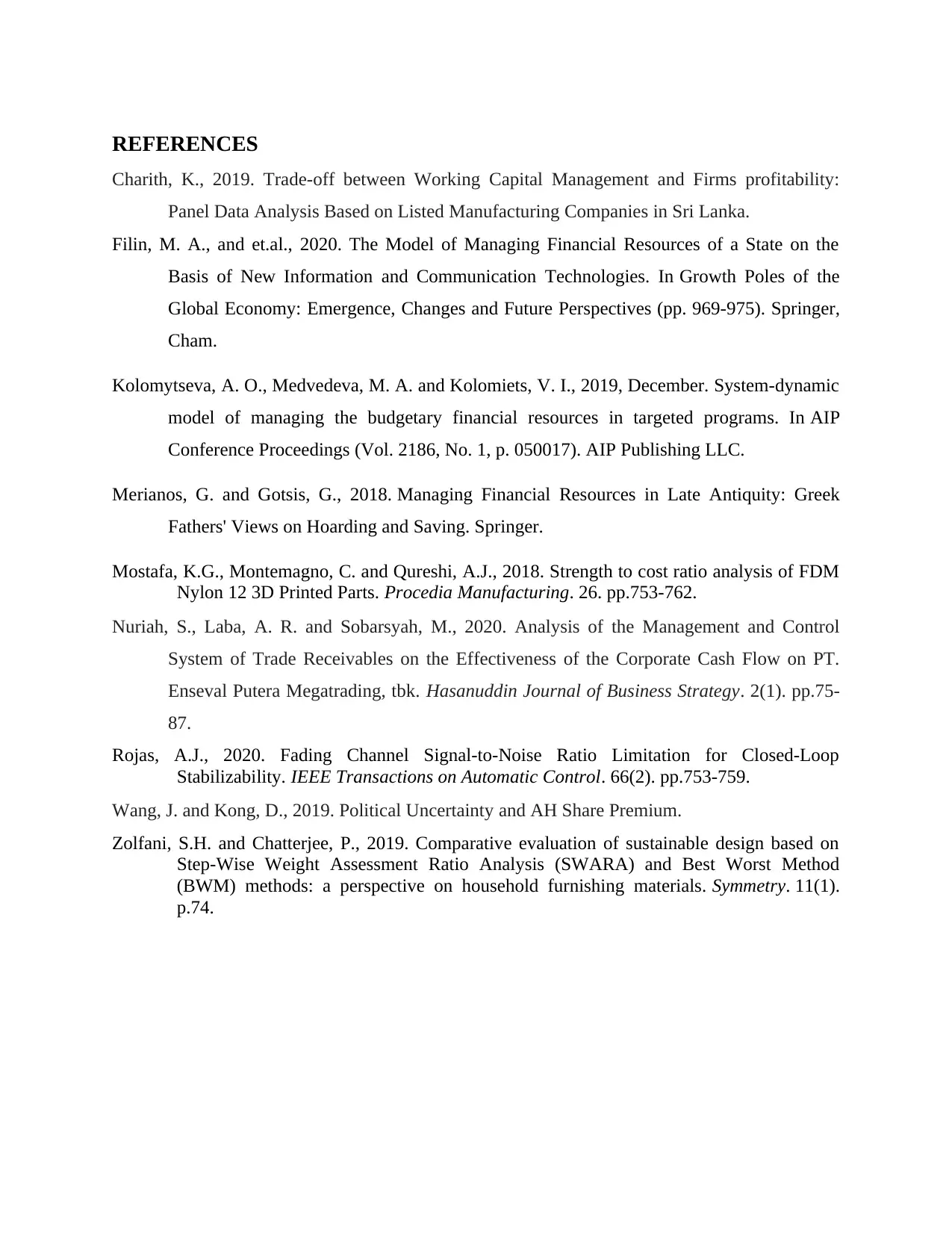
REFERENCES
Charith, K., 2019. Trade-off between Working Capital Management and Firms profitability:
Panel Data Analysis Based on Listed Manufacturing Companies in Sri Lanka.
Filin, M. A., and et.al., 2020. The Model of Managing Financial Resources of a State on the
Basis of New Information and Communication Technologies. In Growth Poles of the
Global Economy: Emergence, Changes and Future Perspectives (pp. 969-975). Springer,
Cham.
Kolomytseva, A. O., Medvedeva, M. A. and Kolomiets, V. I., 2019, December. System-dynamic
model of managing the budgetary financial resources in targeted programs. In AIP
Conference Proceedings (Vol. 2186, No. 1, p. 050017). AIP Publishing LLC.
Merianos, G. and Gotsis, G., 2018. Managing Financial Resources in Late Antiquity: Greek
Fathers' Views on Hoarding and Saving. Springer.
Mostafa, K.G., Montemagno, C. and Qureshi, A.J., 2018. Strength to cost ratio analysis of FDM
Nylon 12 3D Printed Parts. Procedia Manufacturing. 26. pp.753-762.
Nuriah, S., Laba, A. R. and Sobarsyah, M., 2020. Analysis of the Management and Control
System of Trade Receivables on the Effectiveness of the Corporate Cash Flow on PT.
Enseval Putera Megatrading, tbk. Hasanuddin Journal of Business Strategy. 2(1). pp.75-
87.
Rojas, A.J., 2020. Fading Channel Signal-to-Noise Ratio Limitation for Closed-Loop
Stabilizability. IEEE Transactions on Automatic Control. 66(2). pp.753-759.
Wang, J. and Kong, D., 2019. Political Uncertainty and AH Share Premium.
Zolfani, S.H. and Chatterjee, P., 2019. Comparative evaluation of sustainable design based on
Step-Wise Weight Assessment Ratio Analysis (SWARA) and Best Worst Method
(BWM) methods: a perspective on household furnishing materials. Symmetry. 11(1).
p.74.
Charith, K., 2019. Trade-off between Working Capital Management and Firms profitability:
Panel Data Analysis Based on Listed Manufacturing Companies in Sri Lanka.
Filin, M. A., and et.al., 2020. The Model of Managing Financial Resources of a State on the
Basis of New Information and Communication Technologies. In Growth Poles of the
Global Economy: Emergence, Changes and Future Perspectives (pp. 969-975). Springer,
Cham.
Kolomytseva, A. O., Medvedeva, M. A. and Kolomiets, V. I., 2019, December. System-dynamic
model of managing the budgetary financial resources in targeted programs. In AIP
Conference Proceedings (Vol. 2186, No. 1, p. 050017). AIP Publishing LLC.
Merianos, G. and Gotsis, G., 2018. Managing Financial Resources in Late Antiquity: Greek
Fathers' Views on Hoarding and Saving. Springer.
Mostafa, K.G., Montemagno, C. and Qureshi, A.J., 2018. Strength to cost ratio analysis of FDM
Nylon 12 3D Printed Parts. Procedia Manufacturing. 26. pp.753-762.
Nuriah, S., Laba, A. R. and Sobarsyah, M., 2020. Analysis of the Management and Control
System of Trade Receivables on the Effectiveness of the Corporate Cash Flow on PT.
Enseval Putera Megatrading, tbk. Hasanuddin Journal of Business Strategy. 2(1). pp.75-
87.
Rojas, A.J., 2020. Fading Channel Signal-to-Noise Ratio Limitation for Closed-Loop
Stabilizability. IEEE Transactions on Automatic Control. 66(2). pp.753-759.
Wang, J. and Kong, D., 2019. Political Uncertainty and AH Share Premium.
Zolfani, S.H. and Chatterjee, P., 2019. Comparative evaluation of sustainable design based on
Step-Wise Weight Assessment Ratio Analysis (SWARA) and Best Worst Method
(BWM) methods: a perspective on household furnishing materials. Symmetry. 11(1).
p.74.
⊘ This is a preview!⊘
Do you want full access?
Subscribe today to unlock all pages.

Trusted by 1+ million students worldwide
1 out of 15
Related Documents
Your All-in-One AI-Powered Toolkit for Academic Success.
+13062052269
info@desklib.com
Available 24*7 on WhatsApp / Email
![[object Object]](/_next/static/media/star-bottom.7253800d.svg)
Unlock your academic potential
© 2024 | Zucol Services PVT LTD | All rights reserved.





